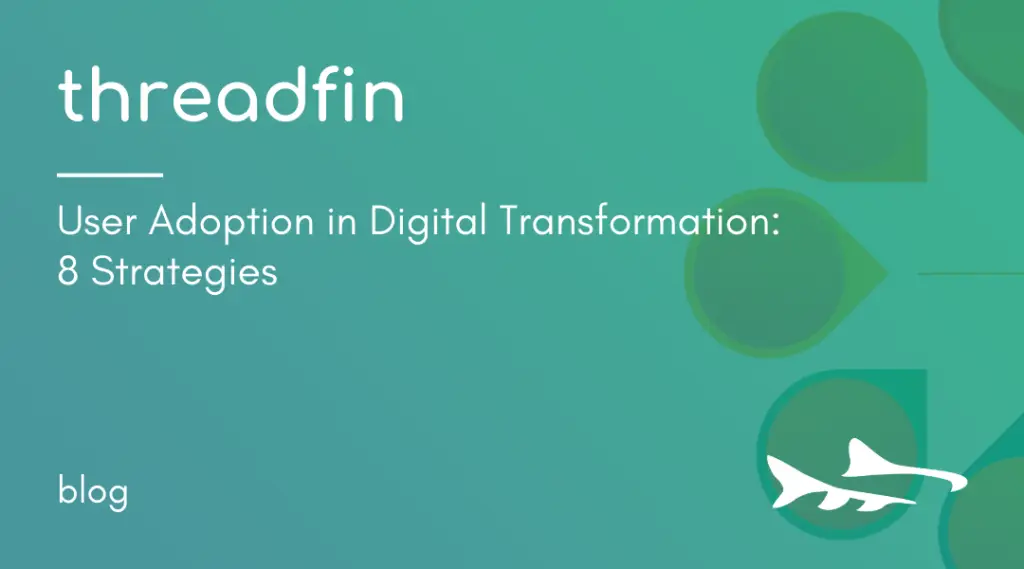Change is a big part of user adoption in digital transformation—and that’s what makes the transformation process especially challenging.
-
- 50% to 80% of people have a natural aversion to change
-
- 60% to 70% of employees exhibit resistance to change
-
- 70% of programs fail because of resistance to change
I’ve spent the majority of my career—over 20 years—in Learning & Development (L&D), Communications and Marketing. During that time, I’ve spearheaded the user adoption aspect of digital transformations at companies that are household names.
Based on that experience, I’ve put together an 8-part framework that we’re using at Threadfin to help business leaders improve user adoption in digital technology:
-
- Culture
- Change Leadership
- Change Management
- Leadership
- Partnership
- Communication
- Training
- Evaluate & Adjust
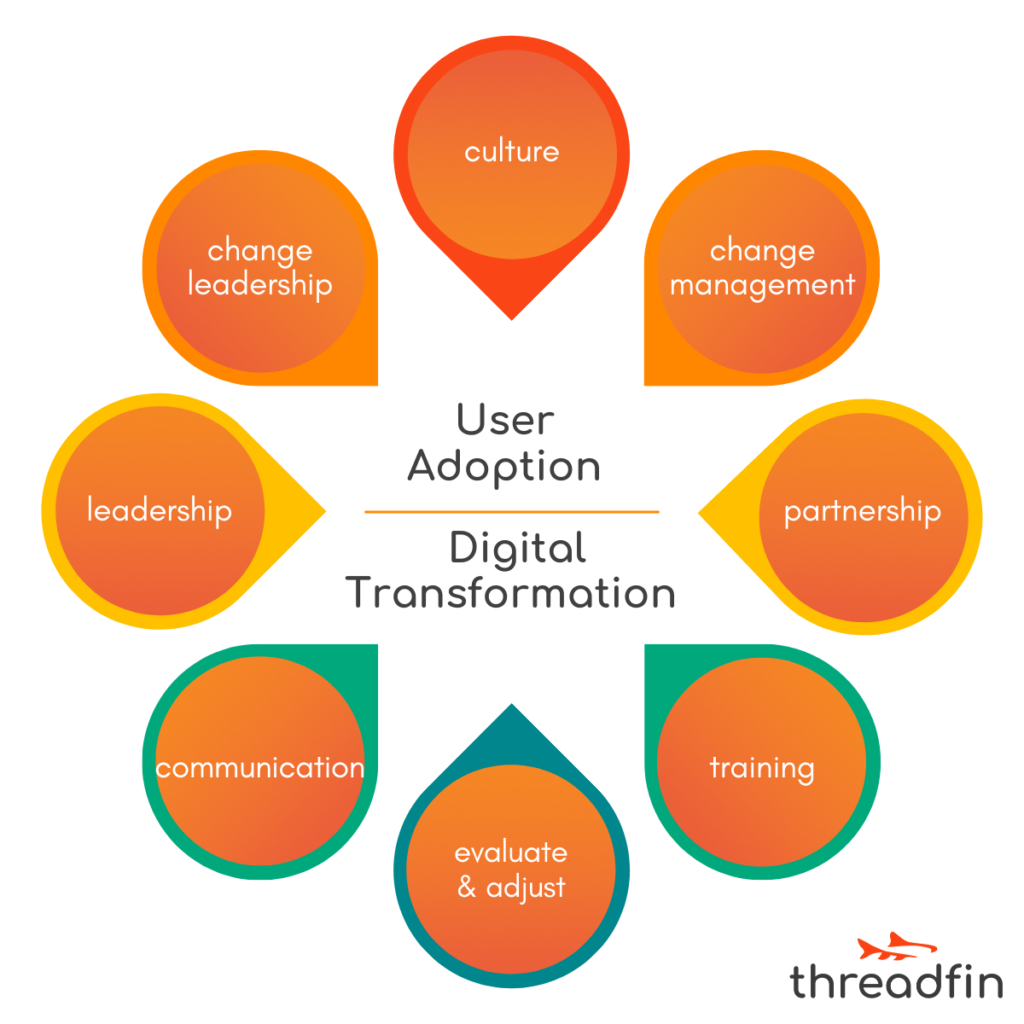
Let’s take a look at how each one makes for a smooth transition…
User Adoption in Digital Transformation: Culture
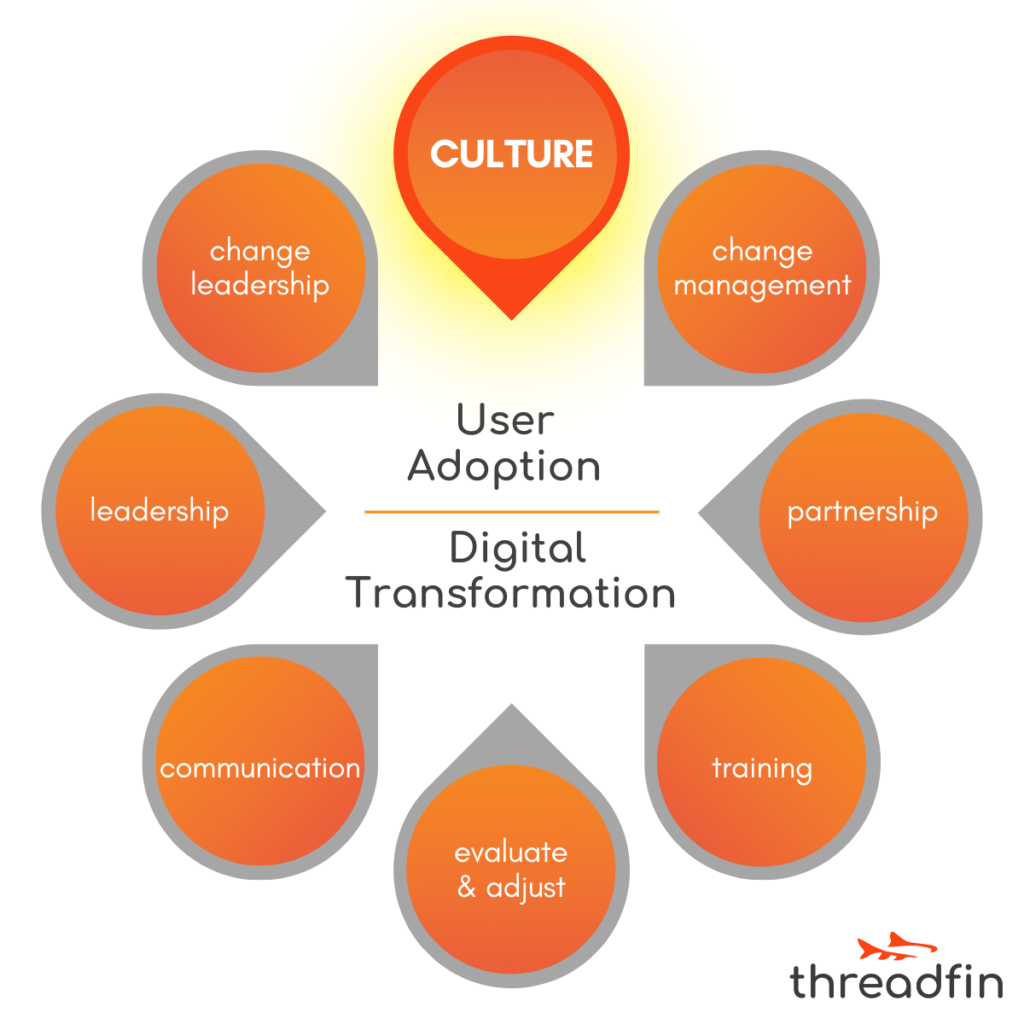
The most successful organizations today have a culture that supports regular communication and continuous learning.
This is especially important when rolling out new technology. Because technology changes rapidly, organizations that can’t quickly respond to new systems and new digital tools will flounder.
When there’s a culture of regular communication:
-
- Everyone is informed and involved.
-
- It’s already customary to coordinate efforts across departments.
-
- Employees are encouraged to think creatively and propose solutions.
When there’s a culture of continuous training:
-
- Employees feel valued and invested in the organization’s success.
-
- They’re fully supported in acquiring the new skills needed to be successful.
-
- Employees are prepared so there’s less disruption and more efficiency.
In both cases, organizations can better understand and respond to customers, resulting in a better customer experience.
If you don’t have this on lock at your organization, here are 5 tips to get you started:
-
- Dedicate resources: Hire an expert or leverage natural aptitude.
- Model behaviors: Talk the talk and walk the walk.
- Set expectations: Communicate those expectations clearly and frequently.
- Encourage openness: Build channels for feedback.
- Meet employees where they’re at—figuratively and literally.
User Adoption in Digital Transformation: Change Leadership
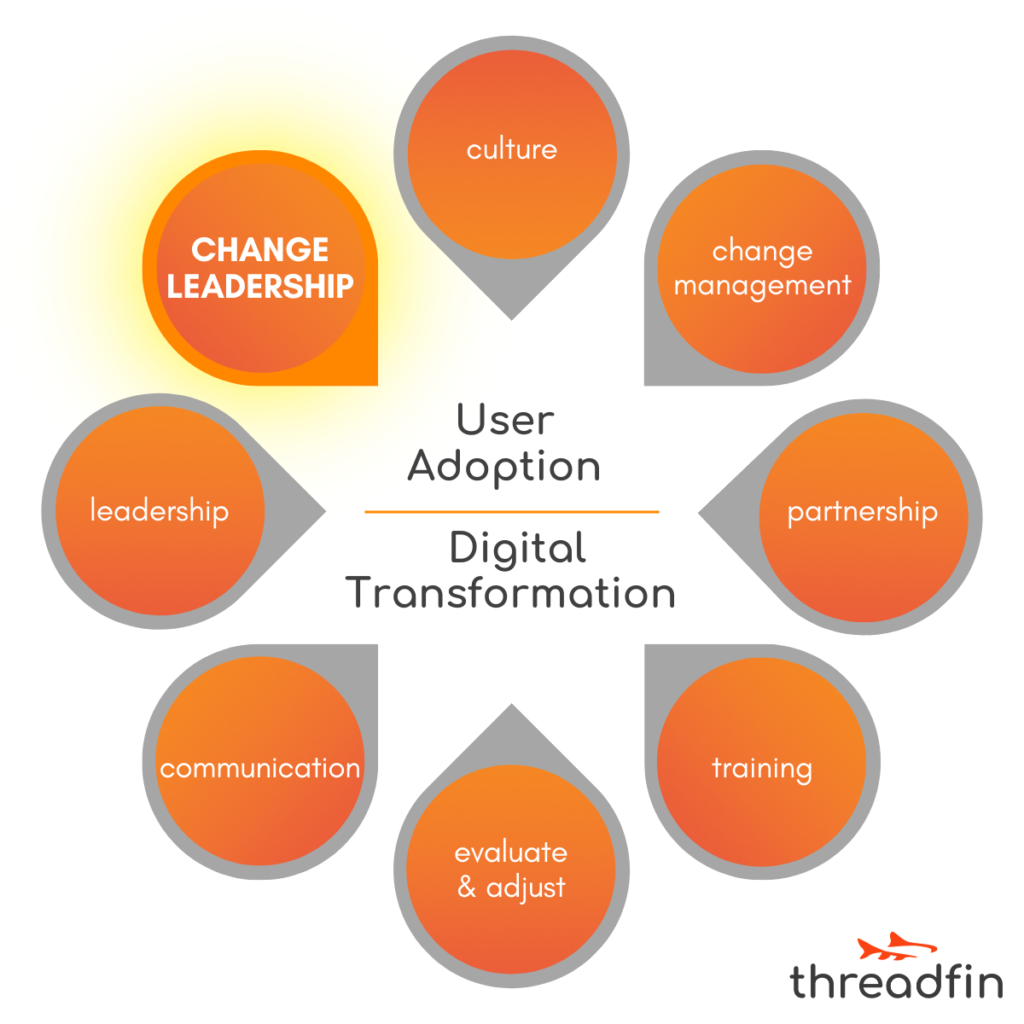
Is change fast and frequent in your industry? It sure is in mine. My career has been spent navigating, communicating and training change.
One thing that can make or break change? Especially in digital transformation? Change leadership.
Not to be confused with change management, here’s a quick compare and contrast:
-
- Change management = systems | processes and tools needed to manage the transition
-
- Change leadership = people | driving and inspiring the overall vision and direction
Leaders have the power to:
-
- Reduce fear and uncertainty
-
- Improve employee buy-in
-
- Smooth the transition
-
- Improve productivity and efficiency
-
- Sustain long-term success
But for that kind of impact, they need to be diligent about change leadership.
Here’s what I’ve seen the most effective leaders do to drive effective change:
-
- Strategy: It’s thorough, built with input from stakeholders
-
- Vision: It’s clear, compelling and aligned with the organization’s goals
-
- Communication: They openly share the process, benefits and impact
-
- Engage: They provide regular updates and seek feedback
-
- Culture: They foster learning, innovation and adaptability
-
- Model: They set a positive tone for the organization
-
- Empathy: They listen to and address concerns
-
- Support: They give employees training and resources for success
-
- Delegate: They leverage leaders, experts, super users and advocates
-
- Encourage: They create an environment where it’s safe to innovate without fear of failure
Change leadership focuses on the human aspects of change. And that’s the most important part of success.
User Adoption in Digital Transformation: Change Management
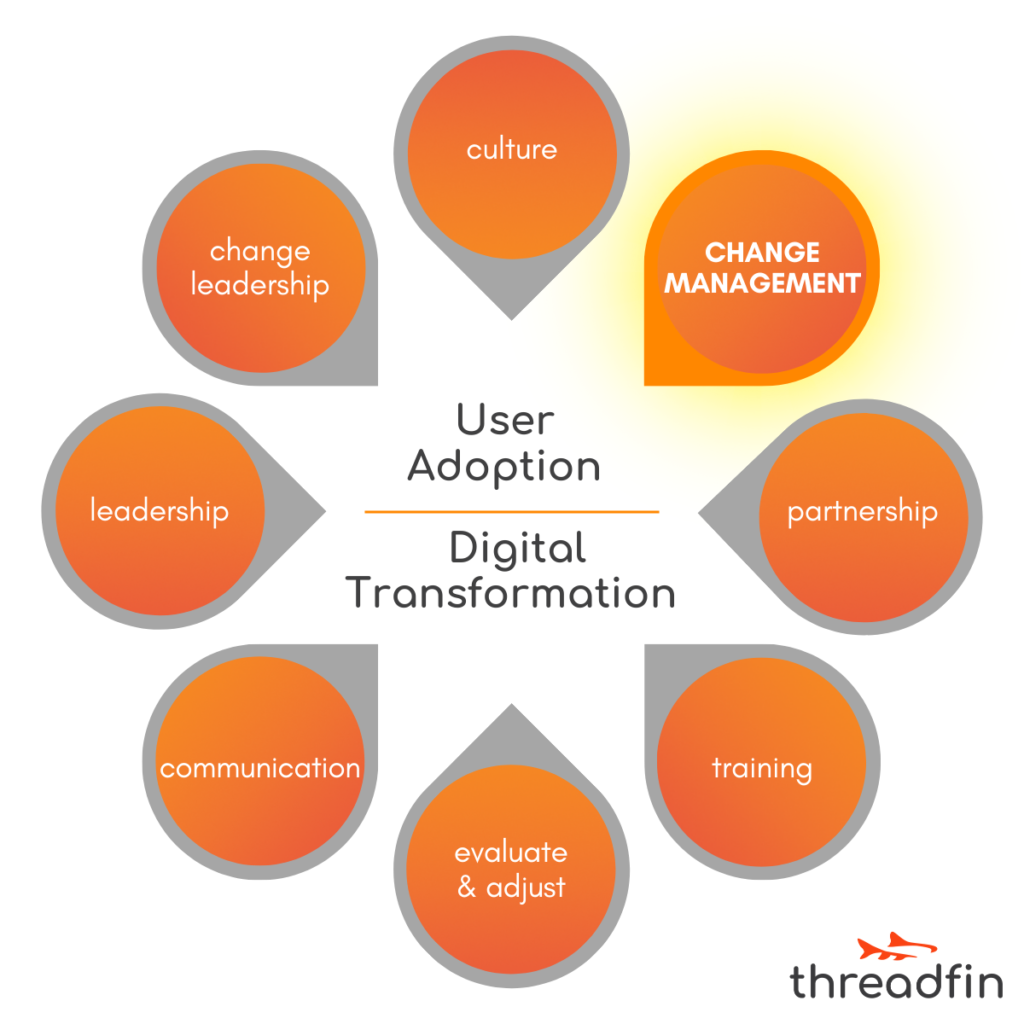
Now let’s look at change management.
There are 2 incredibly important points when it comes to change management. These will make sure your technology investments aren’t made in vain.
First, the most successful change management initiatives I’ve seen include both detailed planning and flexibility. The right systems, processes and tools are important, but so is a willingness to adjust the plan as things unfold.
Second, change management feels time-consuming but you must do it. If you skip it, you risk:
-
- User change resistance
-
- Operational disruption, reduced productivity and efficiency
-
- Increased costs (rework, additional support and lost productivity)
-
- Frustrated employees, decreased morale and potentially higher turnover
-
- Failure to achieve goals
You simply won’t be able to achieve your digital transformation goals without a solid change management program.
On the flip side, if you take the time to do it right, you can expect:
-
- Streamlined processes
-
- Reduced disruptions
-
- Enhanced coordination
-
- Improved resource allocation
-
- Long-term success
Much of the organization has a role to play in change management. Here’s a high-level look at who’s who:
-
- Executive sponsor: Champions the transformation, ensures alignment with strategic goals and secures resources
-
- Change manager: Oversees the entire change management process
-
- Change agents: Key employees advocate for and support the transformation; often involved in pilots
-
- Project manager: Ensures the project stays on track, within scope and on budget
-
- Stakeholder manager: Identifies, analyzes and manages stakeholder expectations and concerns
-
- Communications manager: Develops and implements communication strategies
-
- Training manager: Upskills employees, ensures they have the skills to adopt new tools and processes
-
- Human Resources (HR): Handles personnel issues, aligns change with HR policies, supports employees
-
- IT: Ensures that IT infrastructure and services align with the change requirements
-
- Business analyst: Analyzes the impact on business processes and systems, ensures the change aligns with business objectives and requirements
-
- End users: Provide critical feedback and insights to improve implementation
-
- User experience (UX) designers: Focuses on designing user-friendly digital experiences for high adoption rates and satisfaction
Digital transformation requires careful planning to ensure success. Here’s what goes into effective change management:
-
- Planning
-
- Assessment
-
- Communication
-
- Training
-
- Support systems
-
- Documentation
-
- Feedback loops
-
- Risk management
-
- Resource management
-
- Continuous improvement
Change is constant, but with the right approach to change management, you can ensure that transitions are not only successful but also sustainable.
User Adoption in Digital Transformation: Leadership
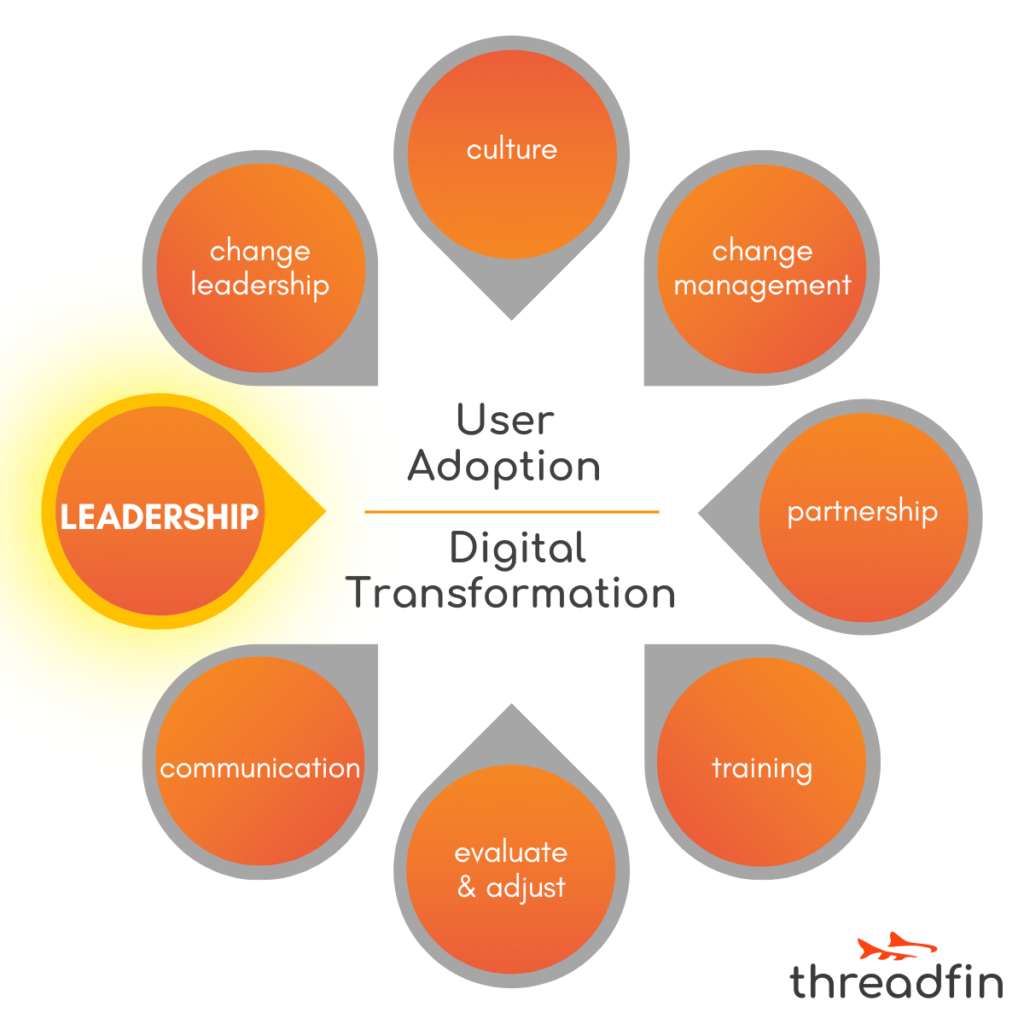
Leadership and Change Leadership aren’t the same thing when it comes to digital transformation initiatives, but they both have a crucial role to play. Here’s a breakdown of the differences between the two:
-
- Leadership: Focused on the overarching strategy and technological implementation
-
- Change Leadership: Focused on the human elements to engage, support and prepare employees
Focus
-
- Leadership: strategic vision | technology integration | innovation | operational efficiency
-
- Change Leadership: human impact | change management | communication | culture adaptation
Responsibilities
-
- Leadership: setting the digital agenda | resource allocation | performance metrics | stakeholder engagement
-
- Change Leadership: managing resistance | employee training | communication plans | monitoring and support
Skills
-
- Leadership: technical acumen | strategic thinking | visionary leadership
-
- Change Leadership: emotional intelligence | communication skills | change management | empathy and support
Both leadership and change leadership are required for successful digital transformation. Change leadership manages resistance, employee engagement, effective communication and cultural adaptation. But leadership handles strategic vision, technology integration, innovation and the efficiency of business operations.
Here’s a more detailed look at the role leadership plays in digital transformation projects:
Strategic vision
Provide a clear and compelling picture of what the organization aims to achieve. This acts as a roadmap, guiding all digital initiatives and ensuring alignment with long-term business goals. Leaders can inspire their teams, align stakeholders and maintain focus during the transformation.
Technology integration
Seamlessly incorporate new technologies into existing systems and processes to minimize disruptions and maximize the benefits of digital tools.
Innovation
Explore new ideas, experiment with emerging technologies and develop unique solutions to business challenges. Leaders can foster a culture of innovation by encouraging creative thinking and providing resources for experimentation. The organization remains competitive and can quickly adapt to market changes.
Operational efficiency
Optimize processes, reduce waste and improve productivity by leveraging digital tools and data analytics to streamline operations and eliminate inefficiencies. This can result in cost savings, faster turnaround times and higher quality outputs, which collectively enhance the overall performance of the organization.
Setting the digital agenda
Define the priorities and goals for the digital transformation journey. Leaders articulate what success looks like, identify key initiatives and establish timelines for coherent and focused effort.
Resource allocation
Effectively distribute financial, human and technological resources to support digital transformation initiatives. Leaders must assess the needs of various projects, prioritize them based on strategic importance and ensure adequate funding and support.
Performance metrics
Measure the success of digital transformation efforts by defining clear, quantifiable metrics aligned with strategic objectives. These metrics help track progress, identify areas for improvement and demonstrate the value of digital initiatives. By regularly reviewing metrics, leaders can make data-driven decisions and adjust strategies as needed.
Stakeholder engagement
Actively involve all relevant parties in the digital transformation process by communicating the vision, benefits and progress of digital initiatives to employees, customers, partners and investors. This builds trust, fosters collaboration, improves employee experience and ensures that everyone is aligned and supportive of the transformation goals.
Technical acumen
While leaders don’t need to be technical experts, having a solid grasp of key technologies enables them to make informed decisions, evaluate opportunities and risks and communicate effectively with technical teams.
Strategic thinking
Navigate uncertainties, identify opportunities and develop adaptive strategies by analyzing complex situations, anticipating future trends and making decisions that align with long-term goals.
Visionary leadership
Articulate a clear, compelling vision, motivate teams to embrace change and foster an environment where creativity and forward-thinking are encouraged.
For best results, ensure that you include Leadership and Change Leadership in your digital transformation.
User Adoption in Digital Transformation: Partnership
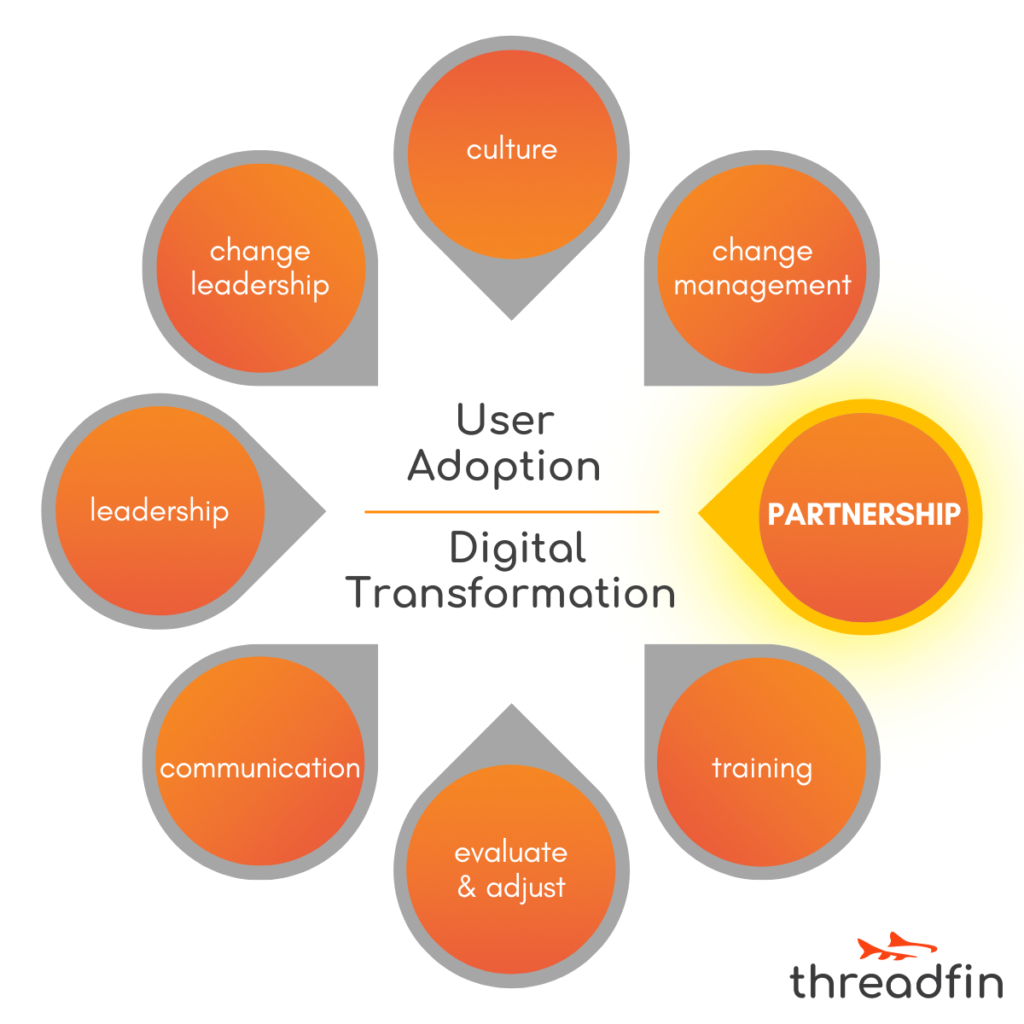
Partnership can make or break digital adoption efforts.
How do I know? I’ve led L&D teams that support effective user adoption strategies and I’ve led communication initiatives that support employees in digital transformation.
Here are 3 effective strategies to foster partnerships:
1 | Don’t push down or out.
Employees need to feel like they’re part of creating the change.
That doesn’t mean the change should be pushed down from leadership or pushed out from the IT department.
Instead, engage employees in the digital transformation strategy through workshops, focus groups and surveys. Use their input and feedback to inform the project. Involve them in pilot programs and beta testing for firsthand experience with the new tools and processes before full-scale implementation.
2 | Engage 4 key roles early in the process.
-
- Project managers ensure that projects are well-coordinated and meet the organization’s goals.
- A support team of super users, early adopters and respected advocates provide valuable insights and promote new tools.
- The communications team makes sure employees and customers are informed and prepared.
- The L&D team has time to put together a digital adoption strategy, understand the process and design effective staff training programs.
3 | Eliminate silos.
For more innovation and to speed up the digital transformation process, teams and individuals need to work collaboratively across departments.
-
- To get diverse perspectives and leverage different skills, create cross-functional teams.
-
- To share updates, challenges and successes, hold regular inter-departmental meetings.
-
- To encourage departments to work together and support each other’s efforts, establish common goals and performance metrics.
Effective partnerships can reduce the inevitable resistance to change and improve outcomes. Take a well-planned approach to partnership in digital transformation for successful implementation.
User Adoption in Digital Transformation: Communication
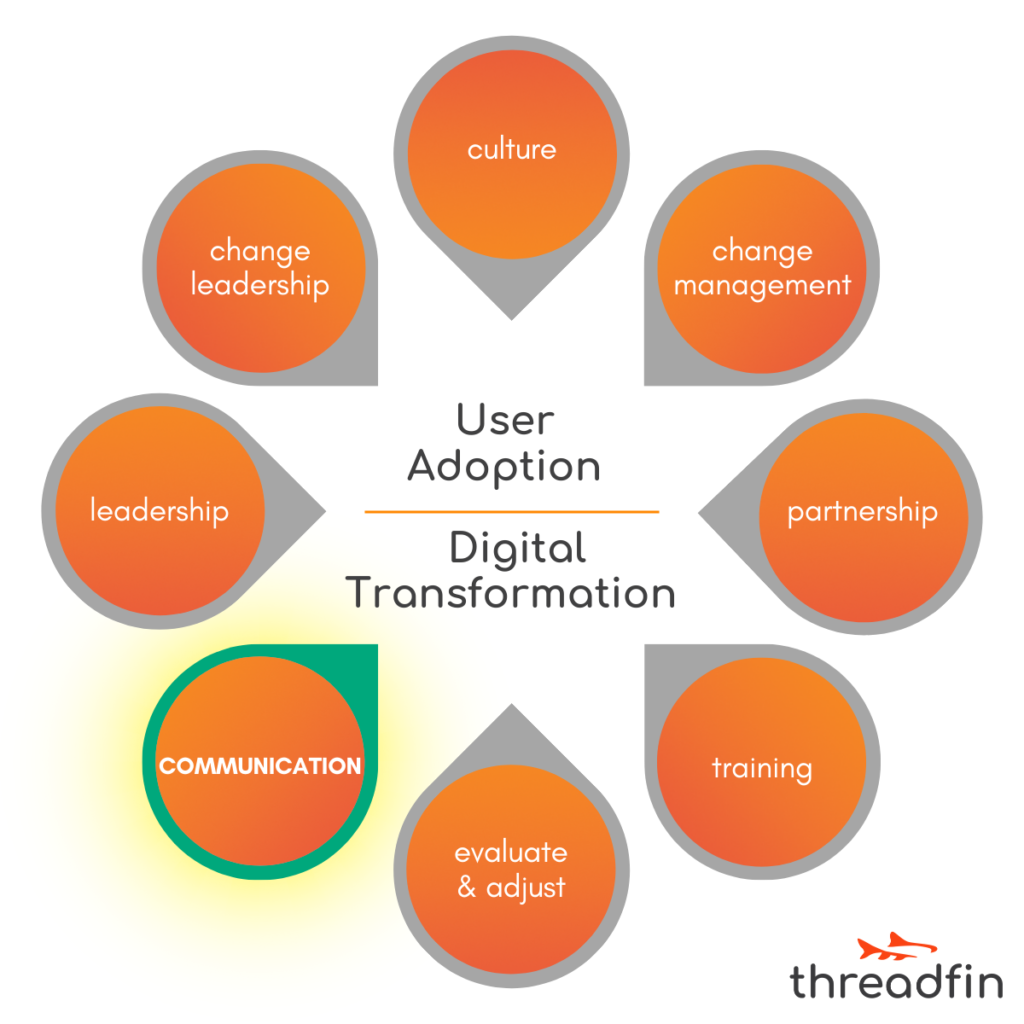
There are 3 hallmarks of a good internal communications program when it comes to digital transformation:
-
- Communicate often.
- Communicate openly.
- Communicate early.
When your internal communications plan uses all 3, you reduce uncertainty and build trust in the organization.
Keep reading for a look at the importance of each in digital transformation initiatives.
1 | Communicate openly.
Make sure employees know…
-
- what changes are taking place
-
- why the changes are taking place
-
- expected outcomes from the changes
-
- the impact changes will have on them
… so that they’re comfortable:
-
- voicing their concerns
-
- asking questions
-
- offering suggestions
2 | Communicate early.
Start communicating early in the process to:
-
- reduce anxiety and uncertainty
-
- reduce rumors and misinformation
-
- set clear expectations
-
- give employees time to prepare and adapt
3 | Communicate often.
Communicate regularly to:
-
- keep employees engaged and informed
-
- maintain a sense of stability and inclusion
-
- identify and address issues promptly
Include these basics in your communication plan:
Objectives
You want clear, measurable goals that are aligned with the overall goals of the digital transformation. These might include raising awareness about the process, encouraging user adoption and ensuring employees understand the benefits of the new systems.
Target audiences
Which specific groups within your organization who will be impacted by the digital transformation? Each audience will have different concerns, levels of technical expertise and information needs, so you’ll need to tailor your communication strategy accordingly.
Key messages
You’ll want to craft your communications to resonate with each target audience. Messages will typically highlight the benefits of the digital transformation, address potential concerns and provide clarity on what the changes will mean for daily work.
Channels
What makes the most sense for each target audience? For desk-based employees, digital channels like email, the company intranet or virtual townhalls might be most effective. Non-desk-based employees might be better served through flyers or team huddles. Use the right mix of digital and non-digital communication to keep everyone informed and engaged.
Timing
Start early to build awareness and continue to communicate regularly throughout the transformation process. Timing should align with key milestones and give employees adequate time to prepare for changes.
Spokespeople
Who does your organization want to hear from? Can you create an advocate group to help spread your message in a more relatable and impactful way?
Two-way communication mechanisms
How are you going to solicit and respond to feedback? Employees will have concerns and you’ll be more successful when you have a plan to address them in a compassionate and constructive manner.
Materials
What makes the most sense for each audience at which point in the process? Tailor the format and content to the needs of each audience group and phase of the transformation.
If your organization doesn’t have an internal communications process in place for digital transformation, now’s the time to get started.
User Adoption in Digital Transformation: Training
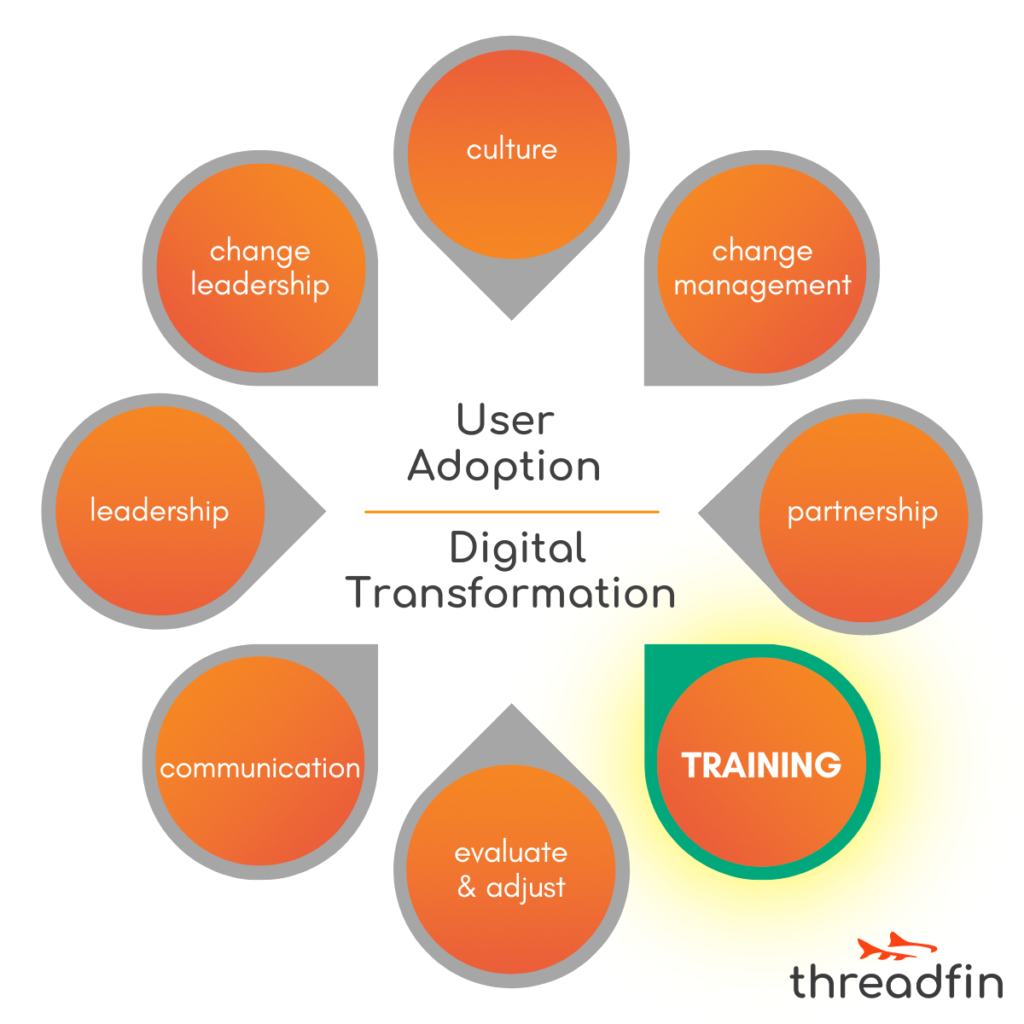
There’s no question that proper training is a vital to digital transformation success.
If employees can’t successfully implement new digital technologies, they won’t be sustainable over the long-term—and the project might not even get off the ground in the short-term.
Here’s a high-level look at 4 things you need to consider when it comes to training for digital transformation:
-
- Roles
- Content & Methods
- Materials
- And more!
1 | Roles
The L&D team often gets roped into tasks best performed by another area of the business.
For example, operations should develop and document any new processes and procedures that come from a digital transformation. The training team should develop their training from those documents with technical input from IT as needed.
2 | Content & Methods
Engage with key stakeholders, leaders and employees to understand their perspectives, challenges and requirements. This will allow you to tailor training content to be more effective.
The training methods you use depend on employee location.
-
- Are they local or dispersed?
-
- Are they remote or at home?
-
- Are they desk-based or in the field?
There are so many effective ways to teach people today, including in-person, virtual, online, micro-learning and more. Tailor your approach to your people.
3 | Materials
Consider which materials will best support your employees. This too will depend on content and location. Do they need desktop procedures? Entire manuals? Job aids? Intranet resources? Should materials be printed or digital? There’s a lot to consider.
4 | And more!
These don’t quite fit into their own section, but they’re definitely worth mentioning.
Bring the L&D team into digital transformation discussions early.
You want to make sure they have the bandwidth and the time to provide stellar support. Especially if you expect there to be a steep learning curve.
Understand the level of change required.
Employees will have some amount of resistance to the change. If you know just how big the change will be for them, you can design the training to help minimize that.
Track, recognize and reward learning.
Make sure employees know that their participation is important—and vital to their success.
Determine the metrics ahead of time.
Partner with operations to determine which metrics will be used to measure success. These could include employee engagement, knowledge retention, application of new skills and overall performance improvements.
Don’t forget the customers.
Sometimes customers will need to be trained too. You’ll want to develop a communication and training plan to support them, in addition to the plans you create for your employees.
User Adoption in Digital Transformation: Evaluate & Adjust
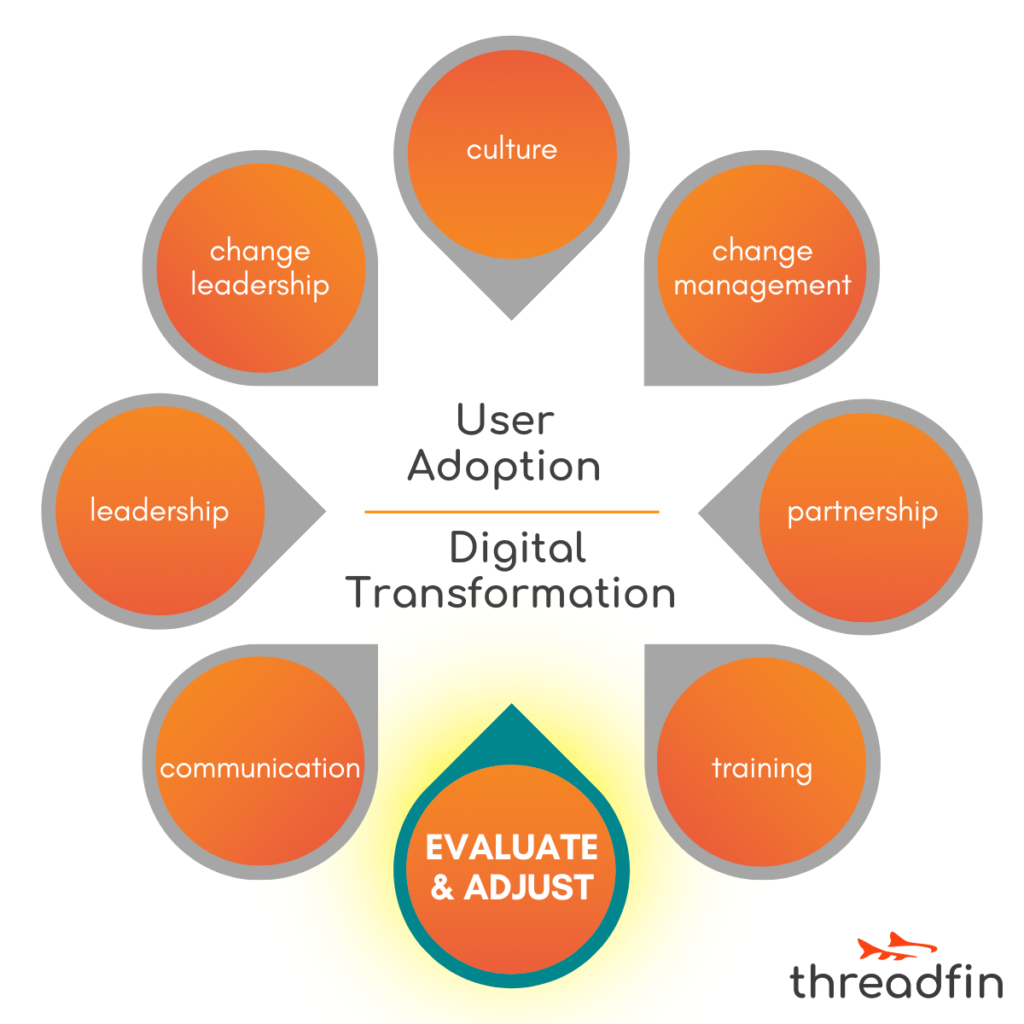
I’m going to start this section with some words of wisdom:
When you create training, you want it to be amazing and perfect. But if the training isn’t meeting expectations or employees are struggling to apply new skills, don’t take it personally. Your training isn’t a failure. Adjusting the training is just part of the job. Remember, you also want successful digital adoption. So take feedback with a smile and get back to work. They’re counting on you!
Now, here’s how I like to approach training evaluation and adjustment…
Evaluate
Have you heard of smile sheets? They’re the feedback forms participants fill out at the end of training. And they aren’t enough.
Yes, they tell us about user engagement—if users found the training enjoyable or engaging. But they don’t tell us if it was effective.
Only the numbers can do that.
Gathering data takes a lot time and effort, but persevere and you’ll be able to look at key performance indicators (KPIs) like user adoption rates, task completion times, error rates and customer experience.
You’ll want to gather this data over a period of time since productivity drops when a new system is implemented and then should increase steadily from there.
Important note: If the business can’t pull the data you need, work with the operations and IT teams on monitoring and reporting capabilities.
While you wait for the data, you can consider:
-
- Observing and listening: Listening to calls, doing ride-alongs and shadowing will let you see exactly what’s happening in the business.
- Assessments: Things like tests, quizzes and practical exercises allow you to evaluate retention and understanding—while also keeping new skills front of mind. With a learning management systems (LMS), assessments are easy to administer and analyze.
Adjust
Be diligent about making changes and improvements to the training and supporting materials based on evaluation results.
Once the program is well underway, I recommend you schedule regular training reviews with subject matter experts to make sure everything is current. This saves you from a total overhaul when things become out of date. In addition, make sure you’re in the loop when standard operating procedures (SOPs) and processes & procedures (P&Ps) are updated so you can make proactive adjustments.
If you need support in planning for user adoption in your next digital transformation, contact us. We know exactly how to set your employees and customers up for success.

